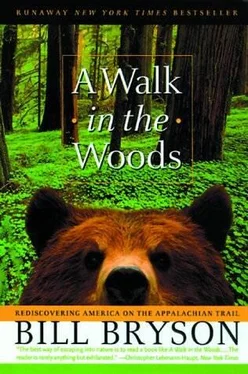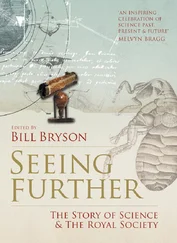Bill Bryson - A Walk In The Woods
Здесь есть возможность читать онлайн «Bill Bryson - A Walk In The Woods» весь текст электронной книги совершенно бесплатно (целиком полную версию без сокращений). В некоторых случаях можно слушать аудио, скачать через торрент в формате fb2 и присутствует краткое содержание. Жанр: Современная проза, на английском языке. Описание произведения, (предисловие) а так же отзывы посетителей доступны на портале библиотеки ЛибКат.
- Название:A Walk In The Woods
- Автор:
- Жанр:
- Год:неизвестен
- ISBN:нет данных
- Рейтинг книги:4 / 5. Голосов: 1
-
Избранное:Добавить в избранное
- Отзывы:
-
Ваша оценка:
- 80
- 1
- 2
- 3
- 4
- 5
A Walk In The Woods: краткое содержание, описание и аннотация
Предлагаем к чтению аннотацию, описание, краткое содержание или предисловие (зависит от того, что написал сам автор книги «A Walk In The Woods»). Если вы не нашли необходимую информацию о книге — напишите в комментариях, мы постараемся отыскать её.
A Walk In The Woods — читать онлайн бесплатно полную книгу (весь текст) целиком
Ниже представлен текст книги, разбитый по страницам. Система сохранения места последней прочитанной страницы, позволяет с удобством читать онлайн бесплатно книгу «A Walk In The Woods», без необходимости каждый раз заново искать на чём Вы остановились. Поставьте закладку, и сможете в любой момент перейти на страницу, на которой закончили чтение.
Интервал:
Закладка:
My wife drove us to the airport in Manchester, through blowing snow, in the kind of awkward silence that precedes a long separation. Katz sat in back and ate doughnuts. At the airport, she presented me with a knobbly walking stick the children had bought me. It had a red bow on it. I wanted to burst into tears-or, better still, climb in the car and speed off while Katz was still frowning over his new, unfamiliar straps. She squeezed my arm, gave a weak smile, and left.
I watched her go, then went into the terminal with Katz. The man at the check-in desk looked at our tickets to Atlanta and our packs and said-quite alertly, I thought, for a person wearing a shortsleeve shirt in winter-“You fellows hiking the Appalachian Trail?”
“Sure are,” said Katz proudly.
“Lot of trouble with wolves down in Georgia, you know.”
“Really?” Katz was all ears.
“Oh, yeah. Coupla people been attacked recently. Pretty savagely, too, from what I hear.” He messed around with tickets and luggage tags for a minute. “Hope you brought some long underwear.”
Katz screwed up his face. “For wolves?”
“No, for the weather. There’s gonna be record cold down there over the next four or five days. Gonna be well below zero in Atlanta tonight.”
“Oh, great,” Katz said and gave a ruptured, disconsolate sigh. He looked challengingly at the man. “Any other news for us? Hospital call to say we got cancer or anything?”
The man beamed and slapped the tickets down on the counter. “No, that’s about it, but you have a real good trip. And hey”-he was addressing Katz now, in a lower voice-“you watch out for those wolves, son, because between you and me you look like pretty good eating.” He gave a wink.
“Jesus,” said Katz in a low voice, and he looked deeply, deeply gloomy.
We took the escalator up to our gate. “And they won’t feed us on this plane either, you know,” he announced with a curious, bitter finality.
Chapter 3
It started with Benton MacKaye, a mild, kindly, infinitely well-meaning visionary who in the summer of 1921 unveiled an ambitious plan for a long-distance hiking trail to his friend charles Harris Whitaker, editor of a leading architectural journal. To say that MacKaye’s life at this point was not going well would be to engage in careless understatement. In the previous decade he had been let go from jobs at Harvard and the National Forest Service and eventually, for want of a better place to stick him, given a desk at the U.S. Labor Department with a vague assignment to come up with ideas to improve efficiency and morale. There, he dutifully produced ambitious, unworkable proposals that were read with amused tolerance and promptly binned. In April 1921 his wife, a well-known pacifist and suffragette named Jessie Hardy Stubbs, flung herself off a bridge over the East River in New York and drowned.
It was against this background, just ten weeks later, that MacKaye offered Whitaker his idea for an Appalachian Trail, and the proposal was published in the somewhat unlikely forum of Whitaker’s Journal of the American Institute of Architects the following October. A hiking trail was only part of MacKaye’s grand vision. He saw the AT as a thread connecting a network of mountaintop work camps where pale, depleted urban workers in the thousands would come and engage in healthful toil in a selfless spirit and refresh themselves on nature. There were to be hostels and inns and seasonal study centers, and eventually permanent woodland villages-“self-owning” communities whose inhabitants would support themselves with cooperative “non-industrial activity” based on forestry, farming, and crafts. The whole would be, as MacKaye ecstatically described it, “a retreat from profit”-a notion that others saw as “smacking of Bolshevism,” in the words of one biographer.
At the time of MacKaye’s proposal there were already several hiking clubs in the eastern United States-the Green Mountain Club, the Dartmouth Outing Club, the venerable Appalachian Mountain Club, among others-and these mostly patrician organizations owned and maintained hundreds of miles of mountain and woodland trails, mainly in New England. In 1925, representatives of the leading clubs met in Washington and founded the Appalachian Trail Conference with a view to constructing a 1,200-mile-long trail connecting the two highest peaks in the east: 6,684-foot Mount Mitchell in North Carolina and the slightly smaller (by 396 feet) Mount Washington in New Hampshire. In fact, however, for the next five years nothing happened, largely because MacKaye occupied himself with refining and expanding his vision until he and it were only tangentially connected to the real world.
Not until 1930, when a young Washington admiralty lawyer and keen hiker named Myron Avery took over the development of the project, did work actually begin, but suddenly it moved on apace. Avery was not evidently a lovable fellow. As one contemporary put it, he left two trails from Maine to Georgia: “One was of hurt feelings and bruised egos. The other was the AT.” He had no patience with MacKaye and his “quasi-mystical epigrams,” and the two never got along. In 1935, they had an acrimonious falling-out over the development of the trail through Shenandoah National Park (Avery was willing to accommodate the building of a scenic highway through the mountains; MacKaye thought it a betrayal of founding principles) and they never spoke again.
MacKaye always gets the credit for the trail, but this is largely because he lived to be ninety-six and had a good head of white hair; he was always available in his later years to say a few words at ceremonies on sunny hillsides. Avery, on the other hand, died in 1952, a quarter-century before MacKaye and when the trail was still little known. But it was really Avery’s trail. He mapped it out, bullied and cajoled clubs into producing volunteer crews, and personally superintended the construction of hundreds of miles of path. He extended its planned length from 1,200 miles to well over 2,000, and before it was finished he had walked every inch of it. In under seven years, using volunteer labor, he built a 2,000-mile trail through mountain wilderness. Armies have done less.
The Appalachian Trail was formally completed on August 14, 1937, with the clearing of a two-mile stretch of woods in a remote part of Maine. Remarkably, the building of the longest footpath in the world attracted almost no attention. Avery was not one for publicity, and by this time MacKaye had retired in a funk. No newspapers noted the achievement. There was no formal celebration to mark the occasion.
The path they built had no historical basis. It didn’t follow any Indian trails or colonial post roads. It didn’t even seek out the best views, highest hills, or most notable landmarks. In the end, it went nowhere near Mount Mitchell, though it did take in Mount Washington and then carried on another 350 miles to Mount Katahdin in Maine. (Avery, who had grown up in Maine and done his formative hiking there, was most insistent on this.) Essentially, it went where access could be gained, mostly high up on the hills, over lonely ridges and forgotten hollows that no one had ever used or coveted, or sometimes even named. It fell short of the actual southern end of the Appalachian Mountain chain by 150 miles and of the northern end by nearer 700. The work camps and chalets, the schools and study centers, were never built.
Still, quite a lot of the original impulse behind MacKaye’s vision survives. All 2,100 miles of the trail, as well as side trails, footbridges, signs, blazes, and shelters, are maintained by volunteers-indeed, the AT is said to be the largest volunteer-run undertaking on the planet. It remains gloriously free of commercialism. The Appalachian Trail Conference didn’t hire its first paid employee until 1968, and it retains the air of a friendly, accessible, dedicated outfit. The AT is no longer the longest hiking trail-the Pacific Crest and Continental Divide trails, both out West, are slightly longer-but it will always be the first and greatest. It has a lot of friends. It deserves them.
Читать дальшеИнтервал:
Закладка:
Похожие книги на «A Walk In The Woods»
Представляем Вашему вниманию похожие книги на «A Walk In The Woods» списком для выбора. Мы отобрали схожую по названию и смыслу литературу в надежде предоставить читателям больше вариантов отыскать новые, интересные, ещё непрочитанные произведения.
Обсуждение, отзывы о книге «A Walk In The Woods» и просто собственные мнения читателей. Оставьте ваши комментарии, напишите, что Вы думаете о произведении, его смысле или главных героях. Укажите что конкретно понравилось, а что нет, и почему Вы так считаете.












